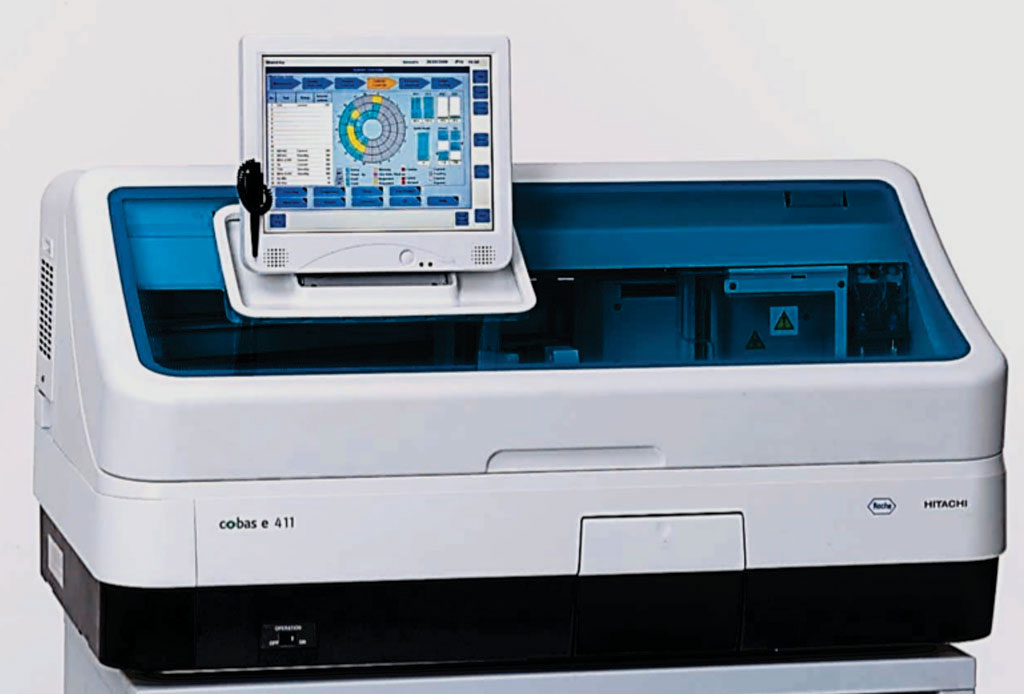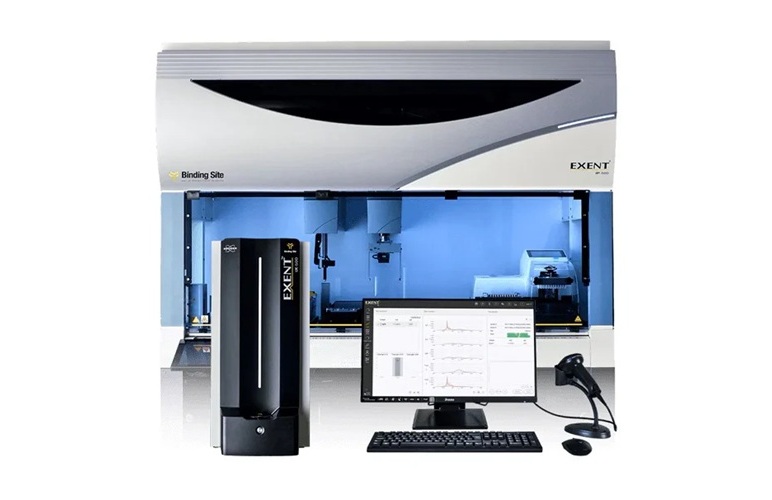Performance of Second Generation Cortisol Assay Evaluated
|
By LabMedica International staff writers Posted on 21 Dec 2016 |

Image: The cobas e 411 fully automated, random access system for immunoassay analysis (Photo courtesy of Roche Diagnostics).
Untreated disorders of the adrenocortical system, such as Cushing’s or Addison’s disease, can be fatal, and accurate quantification of a patient’s cortisol levels is vital for diagnosis. A straightforward diagnostic approach is of essential importance, and accurate quantification of cortisol levels plays a key role in the diagnosis of patients with suspected disease.
Cortisol levels are often measured from a patient’s serum or plasma, which reflects total cortisol, both free and bound. However, in patients with liver disease, and for those receiving estrogen treatments or with critical illness, total serum cortisol levels may be difficult to interpret because of the variation in binding proteins.
Laboratory scientists at the Hospital of the University of Munich (Munich, Germany) and their colleagues performed a technical evaluation of the Elecsys Cortisol II assay (Roche Diagnostics GmbH, Mannheim, Germany) between June and November 2014 at four European investigational sites: three in Germany (Munich, Heidelberg, and Leipzig) and one in Belgium (Ghent). All sites used cobas e 411 analyzers for the Cortisol II assay experiments and in addition to a cobas e 411 system, the Leipzig site utilized a cobas e 601 analyzer. The Cortisol II assay was also compared with in-house isotope dilution liquid chromatography-tandem mass spectrometry (LC-MS/MS) assays.
The team reported that for the method comparison studies, the serum samples covered a measuring range of 1.7 to 1,735 nmol/L and the saliva samples from 1.5 to 209.5 nmol/L. For the 405 serum samples, the agreement between the Cortisol II assay and LC-MS/MS was high, and the mean bias for serum samples measured on the Cortisol II assay compared with LC-MS/MS was 14.55 nmol/L. The correlation coefficient for the relationship between the Cortisol II assays versus LC-MS/MS for 253 saliva samples was 0.993, and for these comparisons, the mean bias was 2.56 nmol/L.
The authors concluded that for the Cortisol II assay, they observed a degree of between-laboratory and between-production lot reproducibility and agreement with several assays of higher metrological order that they consider compatible with the diagnostic use of this assay. The Cortisol II assay will be beneficial to endocrinologists in assessing patients with adreno-cortisol disorders. The study was published on November 29, 2016, in the journal Clinical Chemistry and Laboratory Medicine.
Related Links:
Hospital of the University of Munich
Roche Diagnostics
Cortisol levels are often measured from a patient’s serum or plasma, which reflects total cortisol, both free and bound. However, in patients with liver disease, and for those receiving estrogen treatments or with critical illness, total serum cortisol levels may be difficult to interpret because of the variation in binding proteins.
Laboratory scientists at the Hospital of the University of Munich (Munich, Germany) and their colleagues performed a technical evaluation of the Elecsys Cortisol II assay (Roche Diagnostics GmbH, Mannheim, Germany) between June and November 2014 at four European investigational sites: three in Germany (Munich, Heidelberg, and Leipzig) and one in Belgium (Ghent). All sites used cobas e 411 analyzers for the Cortisol II assay experiments and in addition to a cobas e 411 system, the Leipzig site utilized a cobas e 601 analyzer. The Cortisol II assay was also compared with in-house isotope dilution liquid chromatography-tandem mass spectrometry (LC-MS/MS) assays.
The team reported that for the method comparison studies, the serum samples covered a measuring range of 1.7 to 1,735 nmol/L and the saliva samples from 1.5 to 209.5 nmol/L. For the 405 serum samples, the agreement between the Cortisol II assay and LC-MS/MS was high, and the mean bias for serum samples measured on the Cortisol II assay compared with LC-MS/MS was 14.55 nmol/L. The correlation coefficient for the relationship between the Cortisol II assays versus LC-MS/MS for 253 saliva samples was 0.993, and for these comparisons, the mean bias was 2.56 nmol/L.
The authors concluded that for the Cortisol II assay, they observed a degree of between-laboratory and between-production lot reproducibility and agreement with several assays of higher metrological order that they consider compatible with the diagnostic use of this assay. The Cortisol II assay will be beneficial to endocrinologists in assessing patients with adreno-cortisol disorders. The study was published on November 29, 2016, in the journal Clinical Chemistry and Laboratory Medicine.
Related Links:
Hospital of the University of Munich
Roche Diagnostics
Latest Immunology News
- Gene Signature Test Predicts Response to Key Breast Cancer Treatment
- Chip Captures Cancer Cells from Blood to Help Select Right Breast Cancer Treatment
- Blood-Based Liquid Biopsy Model Analyzes Immunotherapy Effectiveness
- Signature Genes Predict T-Cell Expansion in Cancer Immunotherapy
- Molecular Microscope Diagnostic System Assesses Lung Transplant Rejection
- Blood Test Tracks Treatment Resistance in High-Grade Serous Ovarian Cancer
- Luminescent Probe Measures Immune Cell Activity in Real Time
- Blood-Based Immune Cell Signatures Could Guide Treatment Decisions for Critically Ill Patients
- Novel Tool Predicts Most Effective Multiple Sclerosis Medication for Patients
- Companion Diagnostic Test for CRC Patients Identifies Eligible Treatment Population
- Novel Tool Uses Deep Learning for Precision Cancer Therapy
- Companion Diagnostic Test Identifies HER2-Ultralow Breast Cancer and Biliary Tract Cancer Patients
- Novel Multiplex Assay Supports Diagnosis of Autoimmune Vasculitis
- Blood Test Predicts Immunotherapy Efficacy in Triple-Negative Breast Cancer
- Simple Genetic Testing Could Predict Treatment Success in Multiple Sclerosis Patients
- Novel Gene Signature Predicts Immunotherapy Response in Advanced Kidney Cancers
Channels
Molecular Diagnostics
view channel
Blood Test to Help Low-Risk Gastric Cancer Patients Avoid Unnecessary Surgery
Accurately identifying lymph node metastasis in early-stage gastric cancer remains a major clinical challenge. CT imaging often misses up to half of lymph node–positive cases, leading clinicians to recommend... Read more
First-Of-Its-Kind Automated System Speeds Myeloma Diagnosis
More than 176,000 people are diagnosed with multiple myeloma worldwide each year, yet the current diagnostic pathway can be slow and uncertain, often relying on a highly subjective interpretation of test results.... Read moreHematology
view channel
Platelet Activity Blood Test in Middle Age Could Identify Early Alzheimer’s Risk
Early detection of Alzheimer’s disease remains one of the biggest unmet needs in neurology, particularly because the biological changes underlying the disorder begin decades before memory symptoms appear.... Read more
Microvesicles Measurement Could Detect Vascular Injury in Sickle Cell Disease Patients
Assessing disease severity in sickle cell disease (SCD) remains challenging, especially when trying to predict hemolysis, vascular injury, and risk of complications such as vaso-occlusive crises.... Read more
ADLM’s New Coagulation Testing Guidance to Improve Care for Patients on Blood Thinners
Direct oral anticoagulants (DOACs) are one of the most common types of blood thinners. Patients take them to prevent a host of complications that could arise from blood clotting, including stroke, deep... Read moreImmunology
view channel
Gene Signature Test Predicts Response to Key Breast Cancer Treatment
DK4/6 inhibitors paired with hormone therapy have become a cornerstone treatment for advanced HR+/HER2– breast cancer, slowing tumor growth by blocking key proteins that drive cell division.... Read more
Chip Captures Cancer Cells from Blood to Help Select Right Breast Cancer Treatment
Ductal carcinoma in situ (DCIS) accounts for about a quarter of all breast cancer cases and generally carries a good prognosis. This non-invasive form of the disease may or may not become life-threatening.... Read moreMicrobiology
view channel
Rapid Assay Identifies Bloodstream Infection Pathogens Directly from Patient Samples
Bloodstream infections in sepsis progress quickly and demand rapid, precise diagnosis. Current blood-culture methods often take one to five days to identify the pathogen, leaving clinicians to treat blindly... Read more
Blood-Based Molecular Signatures to Enable Rapid EPTB Diagnosis
Extrapulmonary tuberculosis (EPTB) remains difficult to diagnose and treat because it spreads beyond the lungs and lacks easily accessible biomarkers. Despite TB infecting 10 million people yearly, the... Read more
15-Minute Blood Test Diagnoses Life-Threatening Infections in Children
Distinguishing minor childhood illnesses from potentially life-threatening infections such as sepsis or meningitis remains a major challenge in emergency care. Traditional tests can take hours, leaving... Read more
High-Throughput Enteric Panels Detect Multiple GI Bacterial Infections from Single Stool Swab Sample
Gastrointestinal (GI) infections are among the most common causes of illness worldwide, leading to over 1.7 million deaths annually and placing a heavy burden on healthcare systems. Conventional diagnostic... Read morePathology
view channelAI Tool Outperforms Doctors in Spotting Blood Cell Abnormalities
Diagnosing blood disorders depends on recognizing subtle abnormalities in cell size, shape, and structure, yet this process is slow, subjective, and requires years of expert training. Even specialists... Read more
AI Tool Rapidly Analyzes Complex Cancer Images for Personalized Treatment
Complex digital biopsy images that typically take an expert pathologist up to 20 minutes to assess can now be analyzed in about one minute using a new artificial intelligence (AI) tool. The technology... Read moreTechnology
view channel
AI Saliva Sensor Enables Early Detection of Head and Neck Cancer
Early detection of head and neck cancer remains difficult because the disease produces few or no symptoms in its earliest stages, and lesions often lie deep within the head or neck, where biopsy or endoscopy... Read more
AI-Powered Biosensor Technology to Enable Breath Test for Lung Cancer Detection
Detecting lung cancer early remains one of the biggest challenges in oncology, largely because current tools are invasive, expensive, or unable to identify the disease in its earliest phases.... Read moreIndustry
view channel
Abbott Acquires Cancer-Screening Company Exact Sciences
Abbott (Abbott Park, IL, USA) has entered into a definitive agreement to acquire Exact Sciences (Madison, WI, USA), enabling it to enter and lead in fast-growing cancer diagnostics segments.... Read more






















